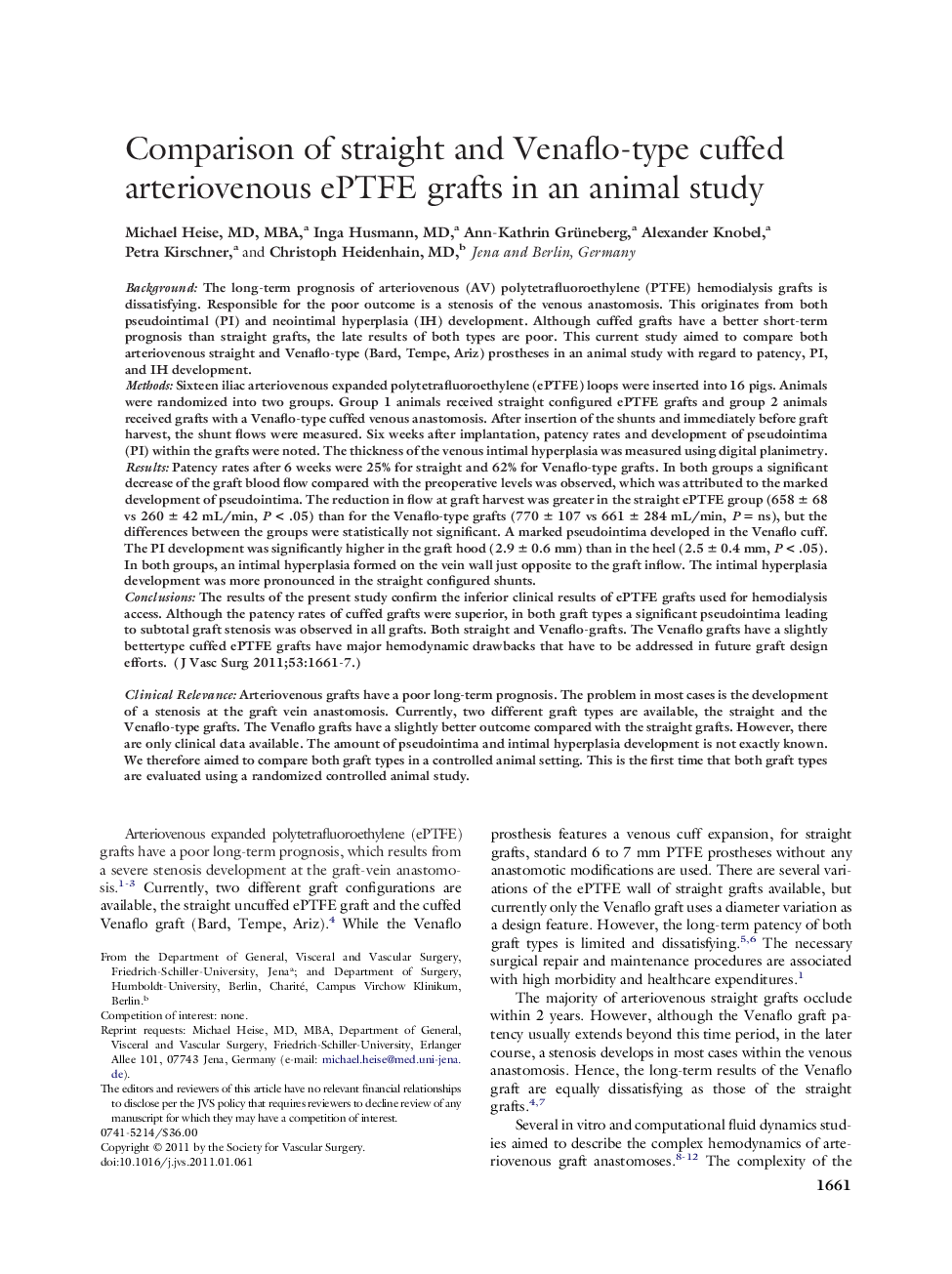| کد مقاله | کد نشریه | سال انتشار | مقاله انگلیسی | نسخه تمام متن |
|---|---|---|---|---|
| 2992671 | 1179884 | 2011 | 7 صفحه PDF | دانلود رایگان |

BackgroundThe long-term prognosis of arteriovenous (AV) polytetrafluoroethylene (PTFE) hemodialysis grafts is dissatisfying. Responsible for the poor outcome is a stenosis of the venous anastomosis. This originates from both pseudointimal (PI) and neointimal hyperplasia (IH) development. Although cuffed grafts have a better short-term prognosis than straight grafts, the late results of both types are poor. This current study aimed to compare both arteriovenous straight and Venaflo-type (Bard, Tempe, Ariz) prostheses in an animal study with regard to patency, PI, and IH development.MethodsSixteen iliac arteriovenous expanded polytetrafluoroethylene (ePTFE) loops were inserted into 16 pigs. Animals were randomized into two groups. Group 1 animals received straight configured ePTFE grafts and group 2 animals received grafts with a Venaflo-type cuffed venous anastomosis. After insertion of the shunts and immediately before graft harvest, the shunt flows were measured. Six weeks after implantation, patency rates and development of pseudointima (PI) within the grafts were noted. The thickness of the venous intimal hyperplasia was measured using digital planimetry.ResultsPatency rates after 6 weeks were 25% for straight and 62% for Venaflo-type grafts. In both groups a significant decrease of the graft blood flow compared with the preoperative levels was observed, which was attributed to the marked development of pseudointima. The reduction in flow at graft harvest was greater in the straight ePTFE group (658 ± 68 vs 260 ± 42 mL/min, P < .05) than for the Venaflo-type grafts (770 ± 107 vs 661 ± 284 mL/min, P = ns), but the differences between the groups were statistically not significant. A marked pseudointima developed in the Venaflo cuff. The PI development was significantly higher in the graft hood (2.9 ± 0.6 mm) than in the heel (2.5 ± 0.4 mm, P < .05). In both groups, an intimal hyperplasia formed on the vein wall just opposite to the graft inflow. The intimal hyperplasia development was more pronounced in the straight configured shunts.ConclusionsThe results of the present study confirm the inferior clinical results of ePTFE grafts used for hemodialysis access. Although the patency rates of cuffed grafts were superior, in both graft types a significant pseudointima leading to subtotal graft stenosis was observed in all grafts. Both straight and Venaflo-grafts. The Venaflo grafts have a slightly bettertype cuffed ePTFE grafts have major hemodynamic drawbacks that have to be addressed in future graft design efforts.
Clinical RelevanceArteriovenous grafts have a poor long-term prognosis. The problem in most cases is the development of a stenosis at the graft vein anastomosis. Currently, two different graft types are available, the straight and the Venaflo-type grafts. The Venaflo grafts have a slightly better outcome compared with the straight grafts. However, there are only clinical data available. The amount of pseudointima and intimal hyperplasia development is not exactly known. We therefore aimed to compare both graft types in a controlled animal setting. This is the first time that both graft types are evaluated using a randomized controlled animal study.
Journal: Journal of Vascular Surgery - Volume 53, Issue 6, June 2011, Pages 1661–1667